
In January 19, 1894, John M. Browning, through attorney Earl Seymour, applied for a patent for the J. M. Browning Magazine Gun. There was no other model nomenclature. Browning’s intention was not to design a rifle for use with smokeless powder cartridges, but rather his design was to simplify and improve upon existing lever action designs for the end results of: reduced weight and size, ease of disassembly, increased feed reliability, and capacity to handle longer cartridges than any other lever action rifle of similar size. In Browning’s patent application wording –

Nowhere in the descriptive text is the issue of strength, the use of a smokeless powder cartridges or special barrel material, nickel steel, indicated. The patent was granted and assigned to Winchester Repeating Arms Company of New Haven, CT by Browning on August 21, 1894 1). After the patent was purchased by Winchester in August of 1894, and after initial production, barrel material was changed from mild steel to a nickel steel to accommodate smokeless powder cartridges 2).
The first Winchester Model 1894 firearms were produced to finished goods inventory in October 1894 and announced to the public in November of the same year. With smokeless powder design cartridges not ready for production, the first Winchester Model 1894 rifles were chambered for the 32-40 WCF and 38-55 WCF black powder cartridges and were made with mild steel barrels. The then new 25-35 WCF and 30 WCF were added to the catalog in August of 1895 and nickel steel became the standard barrel material 3).
The .30-30 WCF was introduced as the .30 WCF, just as were the .32 WCF, .33 WCF and .35 WCF; the charge connotation dropped during the change over from black powder to smokeless. In reviewing early ammo box labels, the name appears this way on Winchester ammunition boxes at least through 1914. Other manufacturers in the industry wanted to chamber their firearms for the new round, but did not want to promote the Winchester name. So they referred to the round as the 30-30 Smokeless, the smokeless charge associated with a 170 grain bullet. Winchester returned the favor by marking their ammo boxes as, “.30 Winchester Smokeless Model 1894” underscored with “For Winchester, Marlin and Savage Rifles” 4).
The Winchester Model 1894 has been a huge success. The company finessed its design to maintain market momentum, capitalizing on trends and configuring for unique applications. Throughout its 5,500,000+ unit run, the Model 1894 has been offered in many barrel lengths, chambers, and grades of finish. There were also functional design improvements that remain today, like the 1983 change to angle eject.
Some changes were transient in nature. The 1979 375 Winchester XTR Big Bore and 1983 chambers for the 307 Winchester and 356 Winchester cartridges served a trend of those times, but were all short lived. Something other lever action rifle manufactures also experienced. There is more than a little nostalgia affixed to the purchase of lever action rifle and more than a little buyer emphasis the right tool for close in, woodland hunting. More than 100 years in production, the venerable 30-30 WCF versions remain the most popular chamber.
Historically speaking, the biggest change
U.S. production of the Winchester Model 1894 ceased in 2006 when the parent company, Fabrique Nationale d’Herstal, closed Winchester’s New Haven, CT plant amidst a struggle with organized labor, state and local politics and with production tooling in need of an overhaul. Shortly after the closing, manufacture of Winchester lever action rifles, to Winchester’s designs and specifications, was moved to the manufacturer B.C. Miroku of Japan. Producing firearms since 1893, Miroku has a long history of manufacturing quality firearms for a number of U.S. companies. Currently, Winchester offers this product in four versions, beginning with the subject rifle.
|
Winchester Model 94 |
|
| Manufactured |
B.C. Miroku of Japan |
| Model Version |
Short Rifle |
| Available Chambers | 30-30 WCF, 38-55 WCF |
| Magazine Capacity | 7 |
| Butt & Fore Stock | Grade 1 Walnut Satin Finished |
| Hardware | Blued Steel Brush Polished |
| Barrel Length |
20″ |
| Twist Rate |
1:12″, 1:15″ & 1:20″ (1) |
| Weight |
6 lbs 12 oz |
| Overall Length | 38″ |
| Length of Pull | 13.5″ |
| Drop at Comb | 1 1/4“ |
| Drop at heel | 1 3/4″ |
| Sights | Marble Semi Buckhorn & Bead |
| Scope Mounting |
Drilled & Tapped |
| Measured Trigger Pull |
5 lbs. 9 oz. |
| Safety | Sliding Tang & Rebounding Hammer |
| MSRP |
$1,229.99 |
|
(1) 38-55 available in 15″ and 20″ twist rates |
|
Other current variations of the Model 94
Model 94 Carbine – As Short Rifle above, excepting: curved buttplate, 20″ twist for 38-55 WCF not available, no forearm cap. MSRP $1,199.99
Model 94 Sporter – As Short Rifle above, excepting: crescent butt plate, checkered stock, half round/half octagon 24″ barrel, no 20″ 38-55 WCF rifling option, 8 round magazine capacity, 7 lbs 8 oz weight, 42 1/2″ overall length. MSRP $1,399.99
Model 94 Trails End Takedown – As Short Rifle above, excepting: Take down feature, no 38-55 WCF 20″ twist rate option, 6 round capacity, 450 Marlin chamber available. MSRP $1,459.99.
A few observations… in no particular order
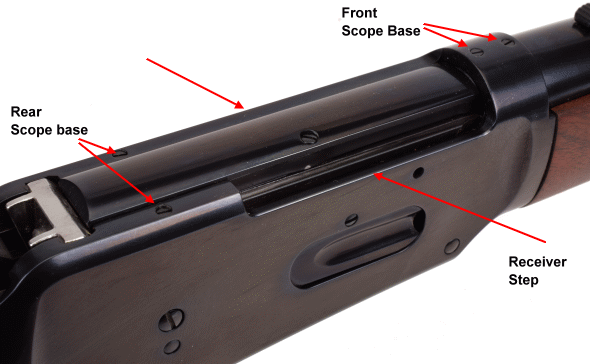
The angle eject version of the Model 94 has stepped receiver side; cut lower on the starboard side than port side. The AE’s extractor is located at 11 o’clock, the spring loaded ejector at approximately 5 o’clock, both on the face of the breech bolt. Chambering a round compresses the ejector, which remains compressed under the rim of the cartridge until the case mouth clears the chamber wall on extraction and the compressed ejector is released to toss the case out at an angle that would clear even low mounted scopes. Prior to the AE system, Model 94 owners had to wear a crash helmet to fend off ejected empties or resort to very high or offset scope mounts.
Below, an easy to operate tang safety has replaced earlier hammer half cock and crossbolt type safeties. A rebounding hammer rests at a position where it is not cocked and not resting against the rifle’s firing pin; accidental discharge insurance in the event of a jarred or dropped firearm.
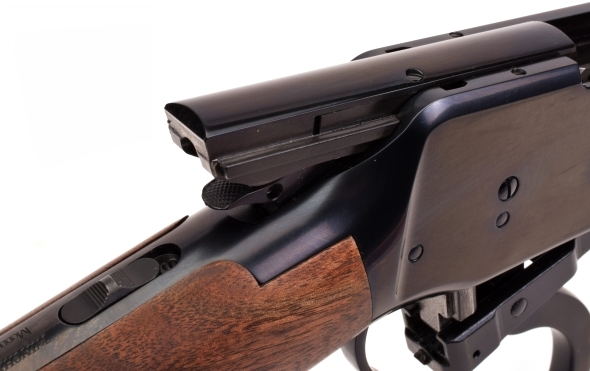
The combination of rails on the breech bolt that ride in reliefs cut into the inside of the receiver and vertical locking bolt makes for a stout, compact action. The vertical locking bolt trunnions are rounded to ease and smooth lever operation. The hole that is visible in the side of the hammer accommodates a hammer spur offset extension that helps when cocking the hammer with a scope installed.
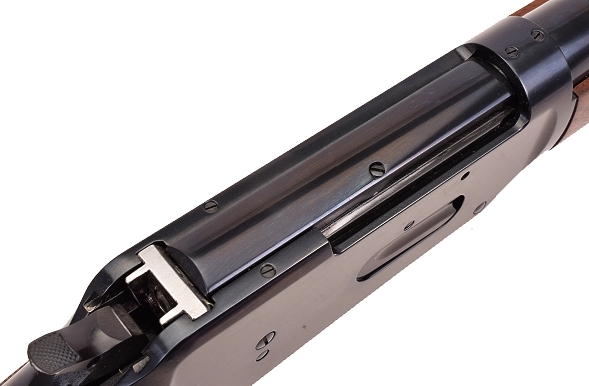
Closed breech, the Model 94’s receiver is clean in appearance. The gap between hammer and firing pin with the hammer in the down, or rebound position, is a bit easier to see.
Below, often referred to as a vertical locking bolt, it is more accurately termed “near vertical” as the lug does have a slight rearward tilt, which is required to make the assembly work. While not the same as the Winchester Model 1873 toggle link action, the Model 94 also incorporates a toggle link which allows cycling a relatively long cartridge in a relatively short action by opening and closing the breech bolt in two stages and shifting the location of the fulcrum.

The first half of the Model 94’s opening lever stroke has the finger lever link screw positioned at the bottom of the camming slot; the lever has maximum mechanical advantage, opens the breech bolt approximately 1/4 of its travel and drives the link fully downward. At this point, the link can not move further, so the finger lever link screw rises to the top of the lever’s camming slot, which reduces the lever’s mechanical advantage, but increases the ratio of breach bolt to lever travel; the second half of the closing lever stroke moves the breech bolt the remaining 3/4 of the way open. Which makes sense as higher mechanical advantage would be in place for initial cartridge extraction. The safety catch assures that the breech bolt is fully in battery before the trigger can be pulled. John Browning…
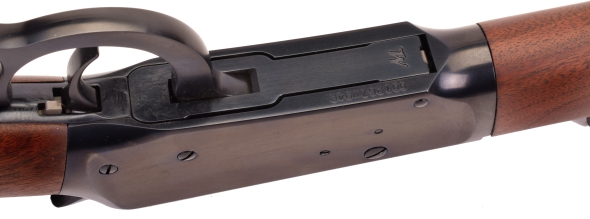
Closed up, the Model 94 bottom is as clean as a solid bottom Model 92. This one’s stock work is closely fit and generally shaped to the adjacent metal pieces… and a little dirty from use.
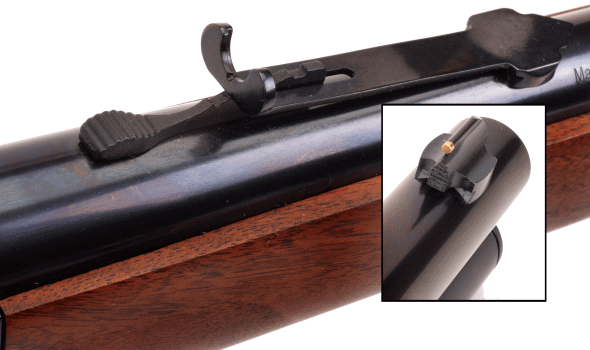
I have to laugh when I hear some folks deem this type of metallic sight as “unusable”, before suggesting that they be changed immediately. I suspect there might be a lot of old cowboys, every day hunters, presidents and dignitaries, celebrities and professional sharpshooters who might take exception to that assessment. Properly adjusted to ammunition, the rear sight elevator in the correct position and the sight drifted as required, they are actually quite fast and quite precise in use.
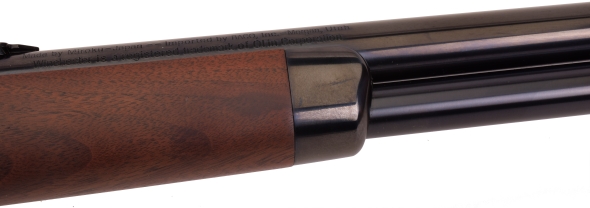
Above and below, the Winchester Model 1894 is made with a lot of quality other manufacturers overlook. From the fit of the forend cap, to the pins on the magazine band to the standoff between the barrel and magazine tube; no scratches from process handling, or misguided screw drivers or les than ideal material handling equipment. A rifle is received in perfect new condition, for the owner to use mark as they see fit, but I have never opened a box to find carelessness in manufacturing handling.
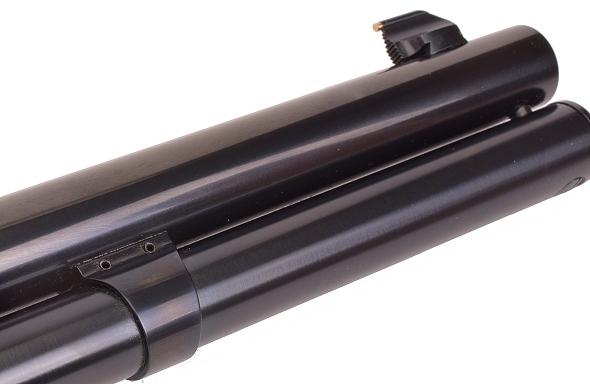
Some bullet points…
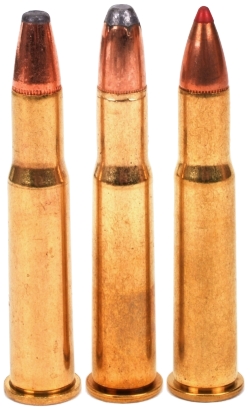
The 30-30 Winchester Centerfire, or .30 Winchester Centerfire if you prefer, is an incredibly successful big game round. Routinely dropping deer of any size, hogs, black bear and any similar size and disposition game, it has also been very successful on larger game. My personal experience with this combination on deer and hogs in sub 150 yard situations has been excellent, and I am sure there is more steam left in the combination.
There are current 43 popular factory loads for the .30-30 Winchester, with bullets weights from 125 to 17o grains. Three factory rounds were selected for this assessment because they were handy and representative of factory ammunition.
| Ammunition | Bullet Type |
Bullet Grains |
Listed FPS |
Actual FPS |
| Federal Fusion | Flat Point | 150 | 2390 | 2442 |
| Winchester Super X | Power Point | 150 | 2390 | 2387 |
| Hornady LeverEvolution | FTX | 160 | 2400 | 2338 |
Chronographed readings are noted as “Actual FPS”. Manufacturers sometimes use different test barrel lengths, so they may or may not be meaningful to a gun buyer. As an example, Hornady uses a 24″ test barrel as the basis for rating the indicated ammunition.
A Leupold VX3 was installed to check out the Winchester’s three shot group potential. Three sets of groups were shot for each ammo type. The targets below are typical of each type. The rings were selected to make the set up comfortable shooting off of a bench. Low rings would have provided sufficient clearance and would have been used if the rifle was headed out for a hunt.
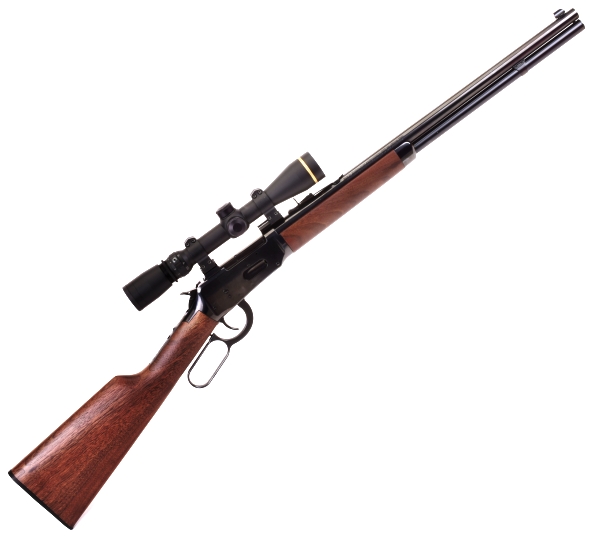
Normally, shooting is done on a dedicated range adjacent to the office. Unfortunately, the persistence of snow drifts has made it mostly inaccessible for the past couple of months and I am not snow shoe ready. A nearby 100 yard straight away that ended with a tree trunk and hill for a backstop was located. A portable shooting bench with rest was set up and it all worked out pretty well. I only zero for the first ammo type and shoot to the same point of aim to collect group size for all. In this case, this project, but also results from over a dozen handloads. Zeroing for each powder charge, bullet type and weight would more than double ammo and time consumed and without good purpose.
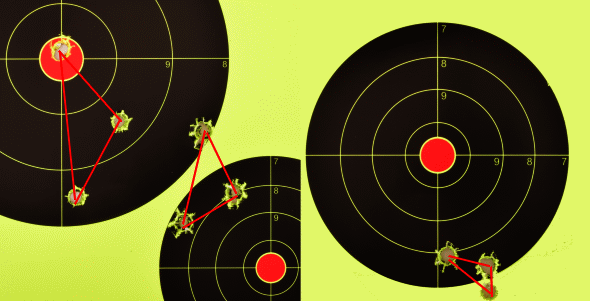
From left to right above, Fusion 150 grain, the velocity leader three shot group size was 2 1/8″, Hornady’s LeverEvolution shot an improved 1 5/8″, Winchester Super X consistently delivered the smallest group size at an excellent lever action group size of 3/4″. Could be a bit of brand nepotism at work here but, based on handloads also shot, I think bullet type, length and shape had a lot more to do with it. The lead core Winchester bullet is only 0.910″ long where the Hornady FTX bullet is 1.128″ and the rifle’s twist rate is 1:12″.
What came to mind five hours later….
Carrying the Winchester around in the woods, crunching through snow was a familiar experience. It felt like every Winchester Model 94 I’ve carried or hunted with over half a century. Walnut feels warm and the smell of gun oil is easily detectable in clean cold air.
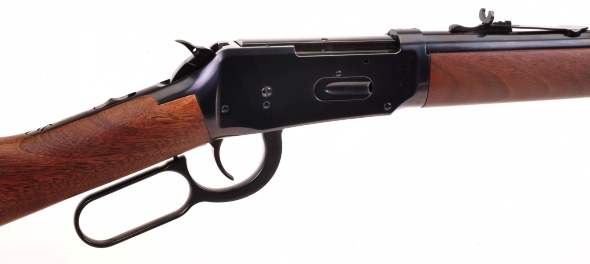
With and without the scope in place, I took some off hand shots and the rifle felt very balanced and settled in my hands. The compact design and light weight also lent itself to shooting from a sitting position. The Winchester was more fun to shoot with metallic sights, however, proper ring height for shooting off of the bench might have altered that perspective.
Shooting from a bench took a little extra effort to fully close the lever against the safety catch, as necessary for the rifle to fire. Consciously making an effort to squeeze at the small of the stock initially distracted from trigger squeeze. This conditioned lessoned with time and shooting and was never apparent when shooting from any field position as one would encounter while hunting.
It is an excellent firearm; well put together, nicely finished and accurate with the right ammo. If there is a sticking point on the way to a purchase it would be the Winchester’s price tag, which is 25% to 50% higher than competing brands. Winchester is a very nice firearm, so I guess it is up to the individual to determine how much “very nice” is worth, factoring in that there really is, only one company making genuine Winchester Model 94 lever action rifles.
1) U.S. Patent and Trademark office – Patent US000524702
2). The History of Browning Firearms – Miller
3) The History of Winchester Firearms 1866 – 1992 – Henshaw
4) Standard Catalog of Winchester – Editor – David D. Kowalski
Winchester’s Model 94 Short Rifle Part 1
Winchester’s Model 94 Short Rifle Part 2

Email Notification